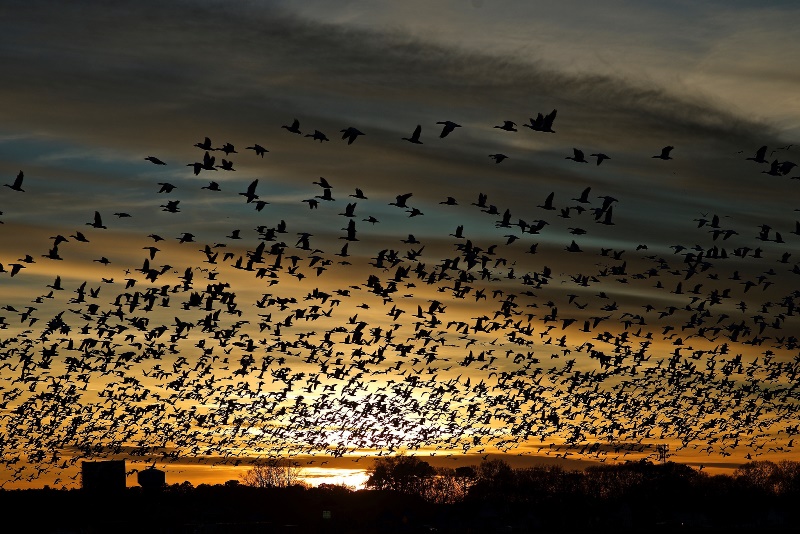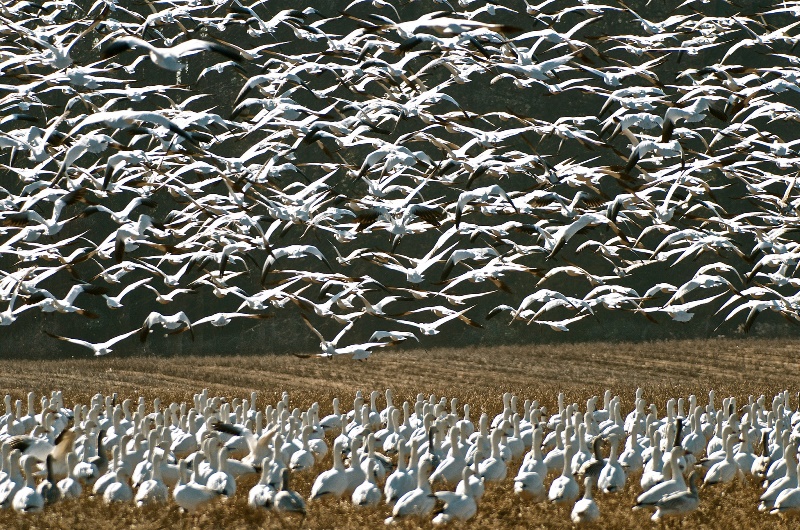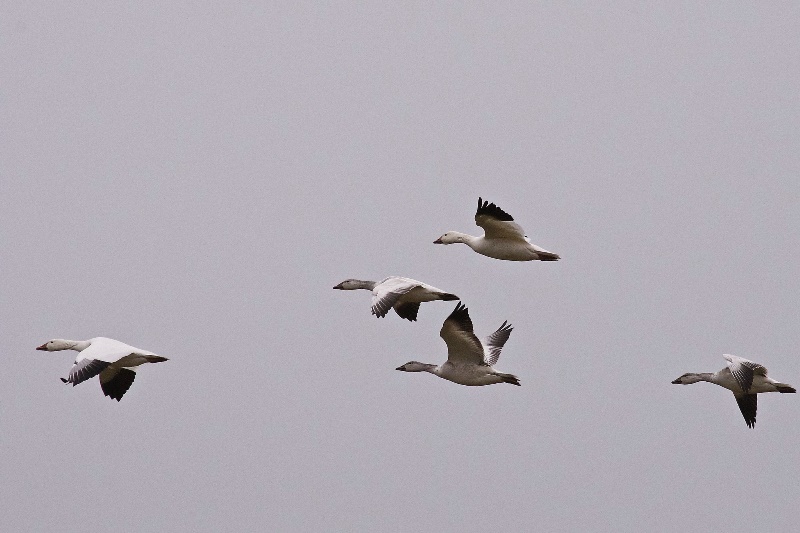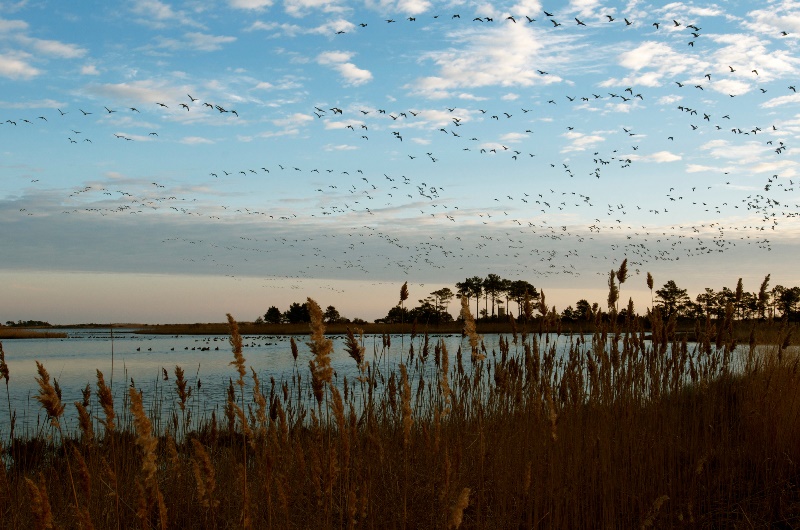 On New Year’s Day, my friend Randy Roberts and I put on white hazmat suits and went out to shoot snow geese. We were told that the birds regard a human in a white suit as one of their own and they let you walk freely among them, something hunters supposedly discovered a while back. We had no intention of killing any snow geese, though: Randy, an accomplished wildlife photographer, was armed with a camera, not a gun.
On New Year’s Day, my friend Randy Roberts and I put on white hazmat suits and went out to shoot snow geese. We were told that the birds regard a human in a white suit as one of their own and they let you walk freely among them, something hunters supposedly discovered a while back. We had no intention of killing any snow geese, though: Randy, an accomplished wildlife photographer, was armed with a camera, not a gun.
We caught up with a gaggle of several hundred birds blanketing a field across the road from the local high school in Lewes, Delaware. To the amusement of passing motorists, we crept up to them in our white suits, looking like inspectors at a superfund site. Just as we got close, they took off in a squawking, whirling blizzard. Nevertheless, Randy got some great shots with the sun setting behind the rising flock.
We have since learned that we should have parked ourselves in a field with some decoys and waited patiently for the geese to come to us. It could have been a long wait: Snow geese are wary birds, and they are consummate survivors. Their numbers, once dangerously low, have increased so dramatically in recent decades that they are now the most numerous waterfowl in North America. They migrate thousands of miles in huge flocks, communicating noisily with each other as they go. And they even have a natural feel for physics. Snow geese start arriving along the Delaware Bay and the Atlantic coast shortly before Thanksgiving. They come in spectacular throngs that fill the sky with long, snaking Vs and wispy diagonal lines. You hear them long before you see them—a cacophony of honks and calls as they chat loudly up and down the ranks. By Christmas, close to a million snow geese have settled in for the winter along the coast from New Jersey to the Carolinas, after traveling some 3000 miles from their breeding grounds in the high Arctic.
Snow geese start arriving along the Delaware Bay and the Atlantic coast shortly before Thanksgiving. They come in spectacular throngs that fill the sky with long, snaking Vs and wispy diagonal lines. You hear them long before you see them—a cacophony of honks and calls as they chat loudly up and down the ranks. By Christmas, close to a million snow geese have settled in for the winter along the coast from New Jersey to the Carolinas, after traveling some 3000 miles from their breeding grounds in the high Arctic.
I have a special fondness for these birds. The day my wife Anne and I bought our house in Lewes 2 years ago, a huge, raucous flock flew directly overhead, bringing our conversation to a halt—and smiles to our faces. It was my first encounter with snow geese, and I wanted to know more about them. (As with all things ornithological, the renowned Cornell University Lab of Ornithology is a good place to start.)
The geese that overwinter in marshes and wetlands along the Atlantic coast belong to a distinctive subspecies, Chen caerulescens atlanticus or greater snow goose. They nest in far northeast Canada and the northwest tip of Greenland from early June to late August, when they start their journey south to warmer climes. When you see these huge flocks, it’s hard to believe that a century ago there may have been just a few thousand greater snow geese in the world.
A slightly smaller subspecies, appropriately called the lesser snow goose, C. caerulescens caerulescens, nests in the Arctic regions of central and western Canada, northern Alaska, and the eastern tip of Siberia. The bulk of them spend their winters in the southern prairies, the Mississippi delta, and around the northern and western shores of the Gulf of Mexico. Other populations overwinter in parts of the southwest and along the Pacific coast from northern California to British Columbia. Lesser snow geese may be smaller individually than their Atlantic cousins, but there are now far more of them—an estimated 5 million or so.
A flock of snow geese would once have been a rare sight. Populations had dwindled to such low levels by the 1900s that hunting the birds was restricted across the United States and banned entirely in the east until 1975. In the final quarter of the 20th century, however, populations exploded. The key was probably a shift in diet.
 Snow geese feed on plants, and they eat every part–roots, shoots, stems, and leaves. Their staple food is marsh plants such as spartina. But in recent decades they have adapted to eating grains left in the fields after harvesting—the field where we stalked them was a corn field—and, in the spring, they dine on emerging crops such as winter wheat. The result: More geese survive the winter and they arrive in their Arctic nesting grounds in good physical shape.
Snow geese feed on plants, and they eat every part–roots, shoots, stems, and leaves. Their staple food is marsh plants such as spartina. But in recent decades they have adapted to eating grains left in the fields after harvesting—the field where we stalked them was a corn field—and, in the spring, they dine on emerging crops such as winter wheat. The result: More geese survive the winter and they arrive in their Arctic nesting grounds in good physical shape.
Climate change may also have played a part, bringing more hospitable conditions in the Arctic spring and milder winters in the south—which, along with changes in agriculture, may have helped extend the overwintering areas. The greater snow goose population that spends the winter along the Atlantic coast, for example, has shifted north since the 1960s; the largest numbers are now in Delaware and New Jersey rather than North Carolina and Virginia.
The population explosion has had some negative repercussions, however: agricultural damage, furious farmers, and local degradation of some marshlands and nesting grounds, as huge flocks tear out the vegetation. So, to try to keep populations in check, Canadian and U.S. authorities have relaxed hunting restrictions in in recent years.
Aside from hunters in white hazmat suits, adult snow geese have few natural predators. Foxes and eagles are their main threat. (Some farmers here in lower Delaware place cutouts of bald eagles alongside their fields in an effort to keep the geese out.) The birds themselves take precautions: Gaggles of feeding geese post lookouts to warn the flock if any eagles appear.
 Keeping watch for the rest of the flock may seem like an altruistic undertaking for a goose, but these are highly cooperative animals. Like other geese, they migrate in formations in which each bird gets a lift from the one in front. A paper in Nature earlier this year confirmed that a bird called a northern bald ibis, which also flies in V formations, senses undulations in the air caused by the flapping wings of the bird in front and positions itself to take maximum advantage of the uplifts. Snow geese presumably do something similar. How do they accomplish this feat? Good question. Scientists are working on it.
Keeping watch for the rest of the flock may seem like an altruistic undertaking for a goose, but these are highly cooperative animals. Like other geese, they migrate in formations in which each bird gets a lift from the one in front. A paper in Nature earlier this year confirmed that a bird called a northern bald ibis, which also flies in V formations, senses undulations in the air caused by the flapping wings of the bird in front and positions itself to take maximum advantage of the uplifts. Snow geese presumably do something similar. How do they accomplish this feat? Good question. Scientists are working on it.
Of course, the poor goose at the point of the V doesn’t get any benefit from fluid dynamics because there’s no bird in front to create an uplift. Again, geese share the burden—they change positions in the formation every so often, giving the leader a break.
For the next 3 months or so, when I drive past the geese in the field where Randy and I tried to pretend we were part of the flock, the sight of these birds gives my mood an uplift. By April, they will be gone, heading back North to the tundra. And soon they may be gone completely from that field: It is slated for yet another retail and housing development. I’ll miss them.
_______
Colin Norman has been a science journalist for more than 40 years. He is the former news editor for Science magazine and currently lives in Lewes, Delaware. He wrote the series of posts on his experience in the Land of Cardiovascular Procedures.
_______
Photos by, and used with the kind permission of, Randy Roberts.
Very well done Colin and I was happy to be a part of your piece. I too love the Snow geese and find much pleasure in the loud “raucous” flocks and gaggles that I see in my daily routines.
Here along the Gulf coast of Texas, many rice farmers promote hunting of geese, by flooding their fields after harvest and it seems to be working as their populations have rebounded in the area. For myself I often see them on my morning commute this time of year and sometimes I stop for a minutes to watch them fly off.